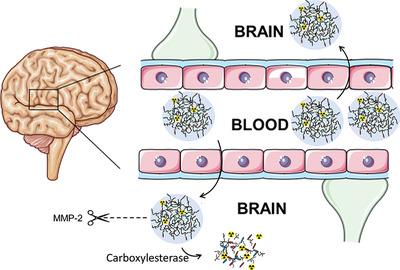当前位置:
X-MOL 学术
›
Adv. Healthcare Mater.
›
论文详情
Our official English website, www.x-mol.net, welcomes your feedback! (Note: you will need to create a separate account there.)
Protease Responsive Nanogels for Transcytosis across the Blood−Brain Barrier and Intracellular Delivery of Radiopharmaceuticals to Brain Tumor Cells
Advanced Healthcare Materials ( IF 10.0 ) Pub Date : 2021-09-06 , DOI: 10.1002/adhm.202100812 Smriti Singh 1, 2 , Natascha Drude 1, 3 , Lena Blank 3 , Prachi Bharat Desai 1 , Hiltrud Königs 4 , Stephan Rütten 4 , Karl-Josef Langen 3, 5 , Martin Möller 1 , Felix M Mottaghy 3, 6 , Agnieszka Morgenroth 3
Advanced Healthcare Materials ( IF 10.0 ) Pub Date : 2021-09-06 , DOI: 10.1002/adhm.202100812 Smriti Singh 1, 2 , Natascha Drude 1, 3 , Lena Blank 3 , Prachi Bharat Desai 1 , Hiltrud Königs 4 , Stephan Rütten 4 , Karl-Josef Langen 3, 5 , Martin Möller 1 , Felix M Mottaghy 3, 6 , Agnieszka Morgenroth 3
Affiliation

|
Despite profound advances in treatment approaches, gliomas remain associated with very poor prognoses. The residual cells after incomplete resection often migrate and proliferate giving a seed for highly resistant gliomas. The efficacy of chemotherapeutic drugs is often strongly limited by their poor selectivity and the blood brain barrier (BBB). Therefore, the development of therapeutic carrier systems for efficient transport across the BBB and selective delivery to tumor cells remains one of the most complex problems facing molecular medicine and nano-biotechnology. To address this challenge, a stimuli sensitive nanogel is synthesized using pre-polymer approach for the effective delivery of nano-irradiation. The nanogels are cross-linked via matrix metalloproteinase (MMP-2,9) substrate and armed with Auger electron emitting drug 5-[125I]Iodo-4”-thio-2”-deoxyuridine ([125I]ITdU) which after release can be incorporated into the DNA of tumor cells. Functionalization with diphtheria toxin receptor ligand allows nanogel transcytosis across the BBB at tumor site. Functionalized nanogels efficiently and increasingly explore transcytosis via BBB co-cultured with glioblastoma cells. The subsequent nanogel degradation correlates with up-regulated MMP2/9. Released [125I]ITdU follows the thymidine salvage pathway ending in its incorporation into the DNA of tumor cells. With this concept, a highly efficient strategy for intracellular delivery of radiopharmaceuticals across the challenging BBB is presented.
中文翻译:

蛋白酶响应纳米凝胶用于跨血脑屏障的胞吞作用和向脑肿瘤细胞提供放射性药物的细胞内递送
尽管治疗方法取得了重大进展,但胶质瘤仍然与非常差的预后相关。不完全切除后的残留细胞通常会迁移和增殖,从而为高抗性神经胶质瘤提供种子。化疗药物的疗效通常受到其选择性差和血脑屏障 (BBB) 的严重限制。因此,开发用于有效转运 BBB 和选择性递送至肿瘤细胞的治疗载体系统仍然是分子医学和纳米生物技术面临的最复杂的问题之一。为了应对这一挑战,使用预聚物方法合成了一种刺激敏感的纳米凝胶,以有效传递纳米辐射。纳米凝胶通过基质金属蛋白酶 (MMP-2,9) 底物交联,并配备俄歇电子发射药物 5-[125 I]Iodo-4”-thio-2”-deoxyuridine ([ 125 I]ITdU) 释放后可以整合到肿瘤细胞的 DNA 中。白喉毒素受体配体的功能化允许纳米凝胶跨肿瘤部位的 BBB 胞吞作用。功能化纳米凝胶通过与胶质母细胞瘤细胞共培养的 BBB 有效地并越来越多地探索转胞吞作用。随后的纳米凝胶降解与上调的 MMP2/9 相关。释放的 [ 125 I]ITdU 遵循胸苷补救途径,最终结合到肿瘤细胞的 DNA 中。有了这个概念,提出了一种跨具有挑战性的 BBB 细胞内递送放射性药物的高效策略。
更新日期:2021-10-21
中文翻译:

蛋白酶响应纳米凝胶用于跨血脑屏障的胞吞作用和向脑肿瘤细胞提供放射性药物的细胞内递送
尽管治疗方法取得了重大进展,但胶质瘤仍然与非常差的预后相关。不完全切除后的残留细胞通常会迁移和增殖,从而为高抗性神经胶质瘤提供种子。化疗药物的疗效通常受到其选择性差和血脑屏障 (BBB) 的严重限制。因此,开发用于有效转运 BBB 和选择性递送至肿瘤细胞的治疗载体系统仍然是分子医学和纳米生物技术面临的最复杂的问题之一。为了应对这一挑战,使用预聚物方法合成了一种刺激敏感的纳米凝胶,以有效传递纳米辐射。纳米凝胶通过基质金属蛋白酶 (MMP-2,9) 底物交联,并配备俄歇电子发射药物 5-[125 I]Iodo-4”-thio-2”-deoxyuridine ([ 125 I]ITdU) 释放后可以整合到肿瘤细胞的 DNA 中。白喉毒素受体配体的功能化允许纳米凝胶跨肿瘤部位的 BBB 胞吞作用。功能化纳米凝胶通过与胶质母细胞瘤细胞共培养的 BBB 有效地并越来越多地探索转胞吞作用。随后的纳米凝胶降解与上调的 MMP2/9 相关。释放的 [ 125 I]ITdU 遵循胸苷补救途径,最终结合到肿瘤细胞的 DNA 中。有了这个概念,提出了一种跨具有挑战性的 BBB 细胞内递送放射性药物的高效策略。



























 京公网安备 11010802027423号
京公网安备 11010802027423号